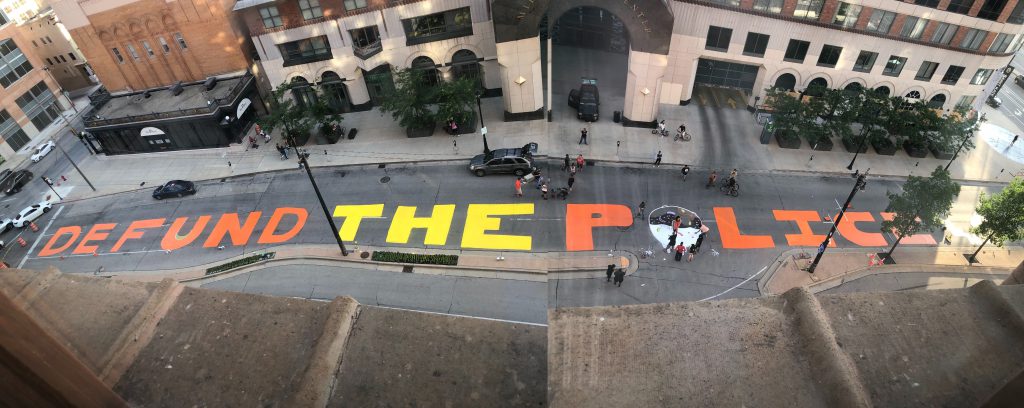Has Defunding Police Movement Failed?
Not entirely, but it’s fallen well short of its goals.
Last summer Mayor Tom Barrett was alarmed by a movement to slash that the city’s budget for police. Community activists in town were pushing for a 25% cut in the budget, potentially cutting the force by more than 400 officers, which the mayor saw as a disaster for Milwaukee. He began contacting council members individually, sources told Urban Milwaukee, and found that some supported the idea. He warned Ald. Mark Borkowski, the council’s most fervent supporter of the the police, that they could face a push for deep cuts.
Across America, the killing of George Floyd by a Minneapolis police officer had created a furor, setting off Black Lives Matter protests in city after city, calling for reform of the police departments. The protests called for “defunding the police,” suggesting that only radical change would satisfy the protestors. In Minneapolis, nine members of the city council — a veto-proof majority — pledged to dismantle the entire Police Department. Officials in many other cities signaled a willingness to significantly cut the police budget.
The idea of reallocating funding made a lot of sense, given the huge increase in the percent of city budgets that goes for policing over the last 50 years. But when described as defunding or “disbanding” the police, a phrase which was also used, it sounded far more radical. What protestors were pushing for was rethinking the police, which would have been a more accurate slogan, but is hardly a call to arms. And so defunding the police became the mantra, one easily distorted in campaign ads by Republicans, suggesting all funding for police would be ended, ads that some believe were damaging to Democratic candidates in the November election.
In reality, radical defunding was unlikely to happen in any city. Particularly in cash-strapped Milwaukee, which unlike most big cities cannot levy a local sales or income taxes. State fiscal constraints, coupled with a huge decline in state aid going back 20 years and rising benefits costs for police and fire officers, meant the city would have to cut the number of officers, even with no cut in the police budget. The mayor ended up proposing a budget with a nearly flat allocation for the police department, which would still require a 120-officer reduction, to be achieved by attrition, not layoffs
The stark reality of the city’s fiscal dilemma took the starch out of the defunding the police movement. There never was majority support for a 25% cut on the council and even 10 percent was a tough sell. The council asked city budget officials to develop a detailed scenario on what such a cut might entail.
The low-hanging fruit in Milwaukee for defunding the police was surely the Milwaukee County Sheriff’s Office, which does little policing of crime in a fully incorporated county with 19 municipal police departments. A strong case could be made that the county is grossly over-policed, And the Sheriff’s department has a history of greatly overspending its allocated budget. Supervisor Ryan Clancy released data showing the department had overspent its generous overtime budget by nearly $62 million over a seven-year period.
Yet nearly every one of Clancy’s proposals to rein in the Sheriff’s spending were rejected by county board members. Ultimately the board passed a cut of just 2.7% in the sheriff’s budget, and given the annual overspending of the sheriff’s overtime budget there is no guarantee the cut will be sustained.
Why did the board gave up on serious defunding? From the beginning it was clear Milwaukee County Executive David Crowley didn’t support a big cut. Sheriff Earnell Lucas seemed to do a good job of selling his budget to Crowley and board members. The fact that Lucas is Black and well respected and that the Deputy Sheriffs have a strong union may have been an influence on various board members.
If defunding struck out in Milwaukee, it had more success nationally. A dozen municipal governments voted for proposals that The Guardian estimated would reduce local law enforcement budgets by a total of more than $1.4 billion, including in big cities like New York City, Los Angeles, San Francisco and Philadelphia.
If you were looking only at Milwaukee the defunding movement doesn’t look very successful. After 200 straight days of marching — a remarkable effort — there was almost no cut in the city or county police budgets. Yet the marches have helped dramatize questionable killings by police and left many appalled by officers’ use of force, tear gas and bullets against peaceful protestors. They have resulted in the resignation of a Wauwatosa police officer who was involved in three killings. The movement has begun a very important discussion about rethinking — and demilitarizing — police. And in many of those cities that cut the police budget, there was a redistribution of funding to housing and social services programs. All incremental changes, to be sure, but’s how change typically happens. And the Black Lives Matter movement, I suspect, is far from finished. There may be more change to come.
Political Contributions Tracker
Displaying political contributions between people mentioned in this story. Learn more.
Murphy's Law
-
National Media Discovers Mayor Johnson
 Jul 16th, 2024 by Bruce Murphy
Jul 16th, 2024 by Bruce Murphy
-
Milwaukee Arts Groups in Big Trouble
 Jul 10th, 2024 by Bruce Murphy
Jul 10th, 2024 by Bruce Murphy
-
The Plague of Rising Health Care Costs
 Jul 8th, 2024 by Bruce Murphy
Jul 8th, 2024 by Bruce Murphy






















